Duane Locke’s erudition gave him an “intense and exalted” appreciation of the arts. Mr. Locke concedes that his painting, The mystical Eve before the creation of Adam has a vision of the Death of Socrates who is very happy for he will be an influence on Immanuel Kant and be written about in ThePostcard by Derrida, “shows the influence of a life spent as a poet and a professor of literature.” He thinks of his art not as mimetic, but as music. He says, “I paint to be heard,” but he also intends for his paintings to be seen. This work of art is a comic strip parody of Ingres’ Death of Socrates and is one of fifty two-by-four feet plywood paintings that made up his Art Garden. Mounted on two-by-fours, these images rose from the ground like totems in the yard beside his home.
Lisa Stone Arts is the exclusive representative of Duane Locke, and has been entrusted by the artist to place his entire body of work. An interpretive paragraph written by the artist accompanies each painting.
|
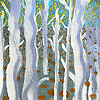
Mystic Forest
This is the presentation of my feelings about all forests. It is not a literal reproduction,
but an intense response, the mystic quiver of the tree trunks, the gold of the fallen leaves on the golden earth.
|
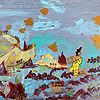
JOIE DE VIVRE
This painting is a celebration of the earth, and if it has any inspiration from the literary it is Rainer Maria Rilke’s “Earth, My darling” in his Duino Elegies.
I celebrate the joyous mystery varied light and the gorgeous atmosphere that the corporeality of the human flesh brings as appearances to the earth. I celebrate kinetic pleasure of shapes that are akin to our neural an visceral shapes. I celebrate the color that comes from the prestidigitation of the magic rods and cones.
|
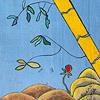
Auxology This painting was inspired by growth, how particulars grow, lengthen, become larger by some unseen force. Growth seems magic, a naturalistic magic, and there is micro growth omnipresent and often omnipotent. This micro growth relates to us and transfigures us.
|
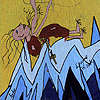
St. Anthony I call the elements I use to express feelings, the light, line, color and shape, visual metaphors. In this painting, I used a gold ground to turn the sky and the rest of the scene into a figuration. The gold ground functions topologically, a trope from medieval painting, to convey a non-scientific atmosphere, a time of another mentally than the mentally that dominated the slave mentality of the 21st century.
My literary inspiration for this painting was Gustave Flaubert’s “The Temptation of Saint Antony,” and Helen Wadell’s “The Desert Saints.” Flaubert depicts how Anthony’s asceticism deceived him and presented him with visions of naked chorus girls. I have Anthony torturing himself on a bed of rocks. I derived this image from St. Benedict’s cave bed in Italy. Benedict’s bed was torturous and uncomfortable rocks.
|
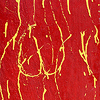
Three Graces “The Three Graces” is another painting of mine that has ancient origins. This time the origin is Greek mythology. Their names are usually Euphrosyne, Aglaea, and Thalia.
They are goddess of joy, of charm, or beauty.
I remember the day I painted it in my Garden of Art in the Tampa Slums. It was an exciting day for the yard was filled with about fifty zebra butterflies. I think the fluttering of the butterflies influenced my brush stroking.
That day I loaded my brush with yellow and let my hand be guided by my cognitive unconscious as I made impasto strokes.
|
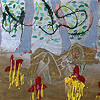
The Past Believing in the Future Becomes a Present Becoming, The Transient Now I am certainly am not purposing to a paint a literal moment, which is actually a scientific moment and not as intense aesthetic moment. Science flattens and discovers what was there before had not been found before and leaves the discovery separable from the perceiver. The aesthetic is opposite, it expands the discovery, turns the discovery into the self, finds in the discovery what has never be found before and never will be found again
|
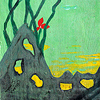
Openness The painting is based on an affective response to the covert mobility of an overt inert scene. Although all paintings when examined by a scientific mentality or a common sense mentality are reduced to being static in what is falsely attributed as a material existence, in aesthetic actuality the paintings or any work art is otherwise.
|
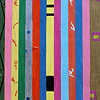
Music of the Earth I wanted to bring into the world what had not been hitherto there, but to create what has not been before I drew upon my fund of experiences of what had been for me. What had been for me was from something else, and selecting and transforming what had been for me I hoped to create what had never been before for anyone, but now that it is here, it is.
|
|